VNG Testing in Tampa – Advanced Eye Movement & Balance Diagnostics
Discover how VNG testing at Genesis Brain Institute in Tampa uses advanced video oculography to detect hidden neurological issues affecting balance, focus, and performance — part of our comprehensive
The Eyes Tell the Brain’s Story
At Genesis Brain Institute, we know the eyes are more than “windows to the soul” — they’re windows to your brain. Every tiny movement your eyes make is controlled by intricate networks in your brain, brainstem, and cranial nerves, as well as your vestibular (balance) system.
Our Video Nystagmography (VNG) Testing — also called Video Oculography (VOG) — uses advanced goggles and high-definition infrared cameras to track your eyes in incredible detail. This allows us to measure how well your visual, balance, and neurological systems are working together.
What we’re looking for isn’t how clearly you see letters on a chart. This is not a vision exam. We’re not checking if you need glasses or contact lenses. Instead, we’re assessing:
- How still your eyes stay when they should be fixed on a target (gaze stability)
- How smoothly they follow moving objects (smooth pursuits)
- How accurately they jump from point to point (saccades)
- How they respond to visual motion in your surroundings (optokinetic reflexes)
- How well they stay on target when your head moves (vestibulo-ocular reflex)
Even slight irregularities in these patterns can point to hidden issues in brain communication, vestibular function, or reflex integration. That’s why VNG testing can detect problems that may be missed in a standard check-up or eye exam.
When combined with our other Quant360 Functional Analysis tests — like qEEG Brain Mapping, Pupillometry, and Balance Testing — VNG helps us build a complete, 360-degree picture of your brain’s current performance. That means we’re not just finding the problem — we’re identifying the best way to help you recover, improve, and thrive.
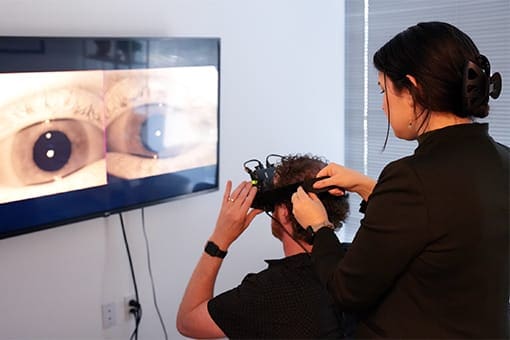
Cutting-Edge VNG Testing Technology for Deeper Neurological Answers
At Genesis Brain Institute, we invest in technology that goes far beyond what you’ll find in a routine medical or vision exam. Our VisualEyes VNG system by Interacoustics is one of the most advanced balance and eye movement testing platforms available today.
This system uses specialized, lightweight goggles with high-speed infrared cameras to record your eyes in both light and complete darkness. Testing in darkness is key — it removes visual distractions and reveals involuntary eye movements (like nystagmus) that aren’t visible during a standard exam. These subtle movements often point to problems in the brain, brainstem, cranial nerves, or vestibular (inner ear) system.
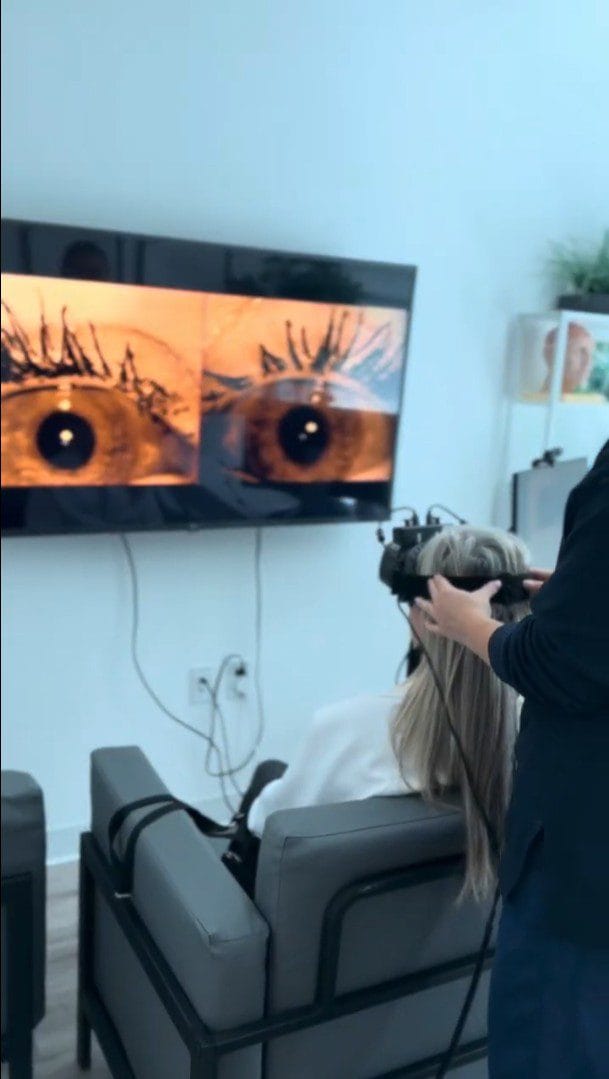
Because VisualEyes tracks every movement frame-by-frame, we can:
- Graph your eye movements for precise measurement and comparison to healthy norms
- Replay the video during your review so you can see exactly what we see
- Correlate results with qEEG Brain Mapping to pinpoint which brain regions are overactive, underactive, or not communicating well
This deeper level of analysis lets us detect subtle signs of:
- Concussion and Traumatic Brain Injury (TBI) – Even if your CT or MRI looked “normal,” micro-level changes in eye control can indicate lingering brain function issues.
- Vestibular (inner ear) dysfunction – Problems in your balance system can cause dizziness, disorientation, or motion sensitivity.
- Neurological disorders – Certain eye movement patterns can signal Parkinson’s disease, early dementia, or other neurodegenerative conditions.
- Reading and focus challenges linked to ADHD – Irregular eye jumps (saccadic intrusions) can make it harder to stay on a word, track a sentence, or sustain attention.
- Sports performance limitations – Delayed reaction times or unstable gaze can affect precision, speed, and coordination on the field or court.
By pairing this cutting-edge VNG data with our GBI Quant360 Functional Analysis, we create a customized plan to retrain and optimize brain function — moving beyond just identifying a problem to actually improving it.
What VNG Testing Reveals About Your Brain
Your eyes don’t just help you see — they act as a direct readout of how well your brain and balance systems are functioning. Each type of eye movement is controlled by specific brain regions and pathways, from the cortex to the brainstem to the cranial nerves.
Our VNG (Video Nystagmography) Testing, also called Video Oculography, evaluates multiple eye movement patterns and reflexes to give us a precise neurological fingerprint.
The Brain Pathways We Measure And What They Reveal About Your Overall Health
- Gaze Fixation – Can your eyes stay perfectly still when looking at a target? Even tiny, involuntary movements (like square-wave jerks or saccadic intrusions) can disrupt focus, pull your attention away, and make it harder to process what you’re seeing. This is especially important for children with attention or reading challenges and adults with post-concussion symptoms.
- Smooth Pursuits – How accurately and smoothly can you follow a moving target at different speeds and directions? Poor smooth pursuit control can lead to motion sensitivity, dizziness, or difficulty tracking fast-moving objects in sports or driving.
- Saccades – These are the rapid, jump-like eye movements you use constantly — from scanning a sentence while reading to shifting your gaze during a conversation. Slow or inaccurate saccades can cause skipped words, reduced reading comprehension, or slower reaction times.
- Optokinetic Reflex – This reflex helps you process visual motion in your environment without consciously thinking about it. It’s what keeps you oriented when trees, cars, or people move past you. Weakness here can contribute to motion sickness, visual disorientation, or balance problems in busy environments.
- Vestibulo-Ocular Reflex (VOR) – This reflex stabilizes your vision when your head moves. Whether you’re jogging and reading a street sign, or turning quickly to catch a ball, a healthy VOR keeps your eyes locked on target. Impaired VOR function is common after concussion, whiplash, or vestibular injury, and it can dramatically affect sports performance and daily activities.
By mapping these patterns, we can identify which brain regions are overactive, underactive, or not communicating effectively. When we cross-reference this with your qEEG Brain Map and other Quant360 diagnostics, we get a clear, actionable plan — whether your goal is recovery, improved focus, or peak performance.

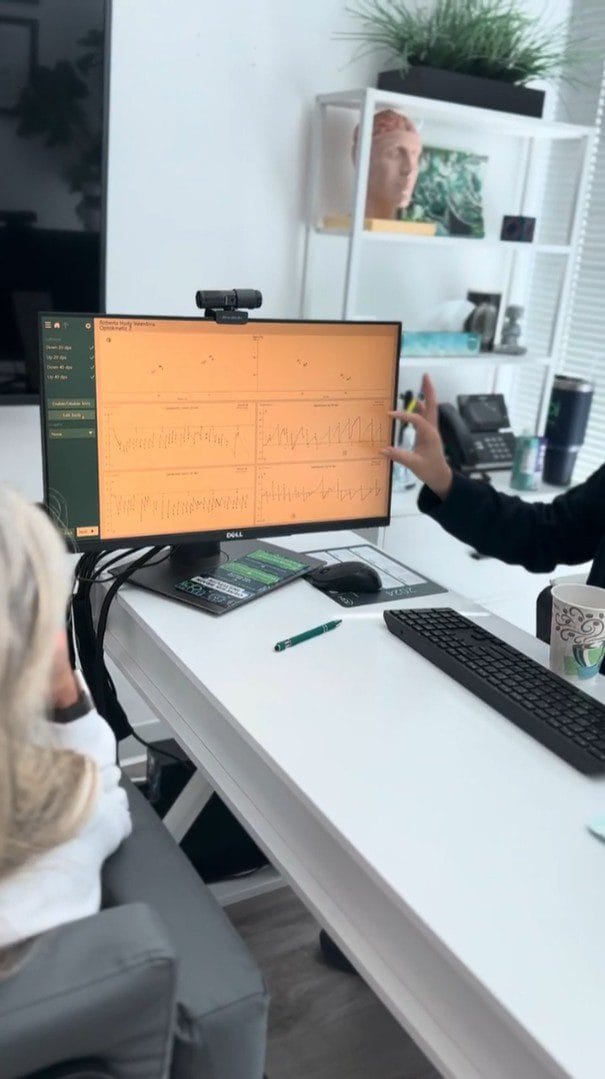
Why VNG Testing Matters for Your Brain and Your Future Health
Small errors in eye movement aren’t just about your eyes — they’re a sign that your brain’s communication networks aren’t working at their best. Because your eyes are connected to so many areas of the brain, even subtle breakdowns in these systems can ripple into daily life.
When brain–eye pathways are disrupted, you might experience:
- Missing words while reading – from delayed or inaccurate saccades in the frontal eye fields and brainstem.
- Losing focus in class or meetings – due to unstable gaze fixation, forcing your brain to work harder just to stay on task.
- Feeling dizzy or off-balance – often linked to vestibular system and cerebellar dysfunction.
- Poor reaction times in sports – when visual tracking and vestibulo-ocular reflexes can’t keep up with the action.
- Chronic headaches or motion sensitivity – caused by overactive or fatigued neural pathways.
At Genesis Brain Institute, VNG Testing helps us trace these symptoms back to the exact brain regions involved. This is how we move from guesswork to precision — targeting your treatment plan to restore healthy brain function.
Whether you’re recovering from a concussion, managing a neurological condition, or seeking a competitive edge, the insights from VNG testing give us a roadmap to get you there.
From Testing to Treatment — And a Life Transformed
When you’ve been through something as life-altering as a stroke, the right treatment plan can mean the difference between simply coping and truly living again.
That’s why at Genesis Brain Institute, VNG Testing is never just a stand-alone result — it’s a vital part of the GBI Quant360 Functional Analysis. This comprehensive approach maps exactly how your brain, balance system, and nervous system are working together (or not) so we can build a treatment plan tailored to you.
Patient Story — “I Got My Life Back”
“After my stroke, I thought the dizziness and balance problems were just my ‘new normal.’ I’d been to multiple doctors, and every test came back ‘fine.’ When I came to Genesis Brain Institute, their testing showed exactly where my brain wasn’t communicating the way it should. The team created a plan just for me, and within weeks, I was walking more steadily, thinking more clearly, and feeling like myself again. This wasn’t just care — it was a turning point in my life.”
For stroke survivors — and anyone recovering from brain injury or neurological challenges — this kind of precision matters. The Quant360 doesn’t just identify the problem; it tells us exactly how to fix it. That’s why our patients call it life-changing.
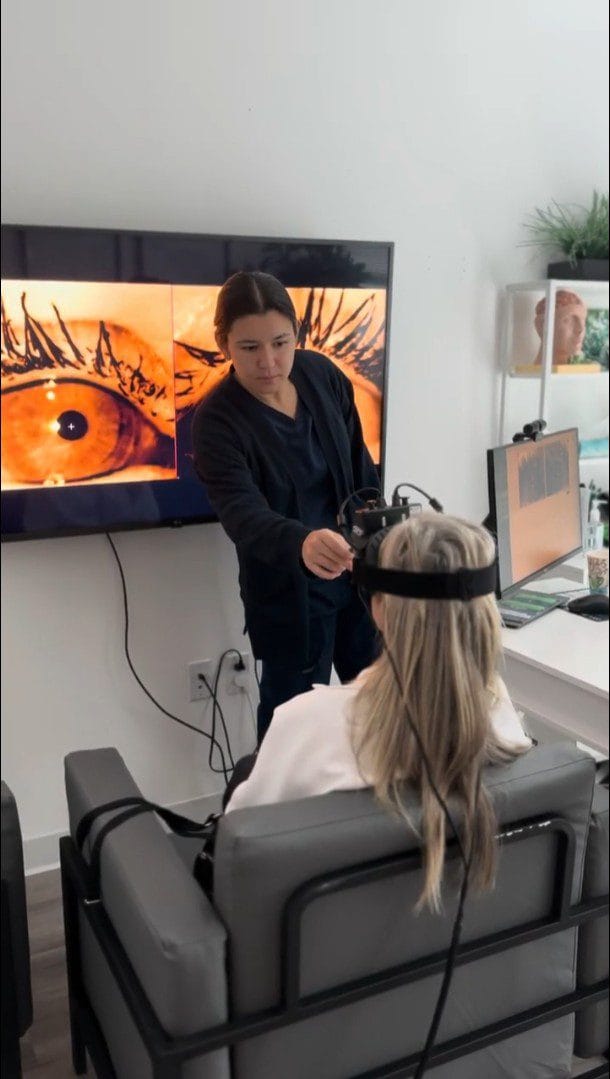
A Different Kind of Diagnostic — The GBI Quant360 Advantage
Most tests give you a label. The GBI Quant360 Functional Analysis gives you a blueprint — and a path forward.
Unlike a routine exam or a one-off test, our VNG evaluation is just one piece of a revolutionary, whole-brain and whole-body diagnostic system found only at Genesis Brain Institute. No other approach combines this depth of testing with a direct plan for recovery and performance.
The Quant360 brings together:
- qEEG Brain Mapping – to measure electrical activity and pinpoint overactive or underactive brain regions.
- Pupillometry – to assess your autonomic nervous system and how your brain responds to light.
- Balance & Proprioception Testing – to evaluate how your brain, body, and inner ear work together to keep you stable.
- Advanced Neurological Metrics – to uncover hidden dysfunctions and performance gaps most providers never check.
The result? Not just data on a page — but a personalized restoration and optimization plan designed to retrain your brain, restore function, and unlock your highest potential. Whether you’re recovering from injury, managing a neurological condition, or striving for peak performance, the Quant360 gives you answers and a clear way forward that no routine diagnostic can match.
Who Should Consider VNG Testing?
- Athletes recovering from concussion or striving for faster reaction times and sharper on-field performance
- Adults living with unexplained dizziness, balance issues, headaches, or brain fog
- Children who struggle with reading, focus, or attention despite “normal” eye exams
- Patients managing neurological conditions such as Parkinson’s, multiple sclerosis, or early cognitive decline
- Anyone seeking a deeper, more precise view into how their brain is really performing
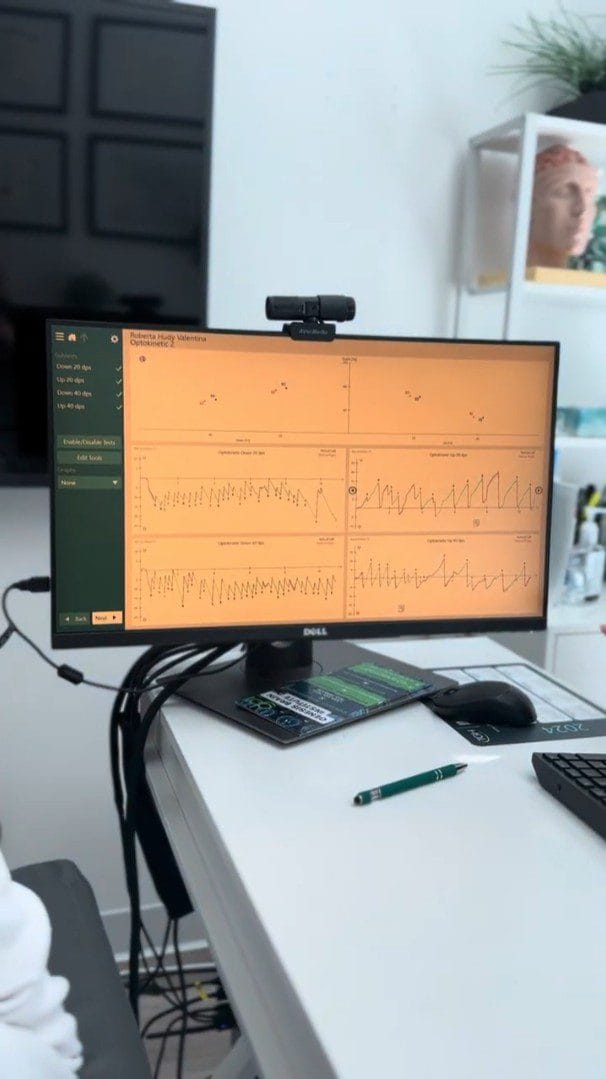

Your Next Step
Whether you’ve been told “everything looks fine” or you just know something is off, VNG testing can uncover the missing piece.
Schedule your Quant360 Functional Analysis today and discover what your eyes can reveal about your brain.
